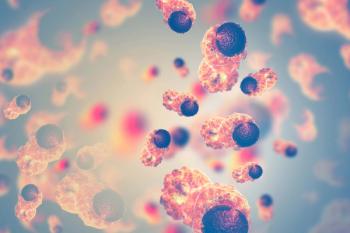
Nivolumab/Chemo Does Not Significantly Improve PFS in EGFR+ NSCLC
The nivolumab with chemotherapy regimen missed the primary end point on the phase 3 trial of patients with EGFR-mutated non–small cell lung cancer.
Treatment with nivolumab (Opdivo) plus chemotherapy did not significantly improve progression-free survival (PFS) compared with chemotherapy alone among patients with previously treated metastatic non–small cell lung cancer (NSCLC) harboring EGFR mutations, according to results from the phase 3 CheckMate 722 trial (NCT02864251).
Nivolumab plus chemotherapy yielded a median PFS of 5.6 months (95% CI, 4.5-6.8) compared with 5.4 months (95% CI, 4.4-5.6) in patients who received chemotherapy alone; the trial did not reach its primary end point (HR, 0.75; 95% CI, 0.56-1.00; P = .0528). The estimated PFS rates in each respective arm were 25.9% vs 19.8% at 9 months, 21.2% vs 15.9% at 12 months, and 14.8% vs 5.9% at 18 months.
Exploratory and post hoc analyses based on baseline characteristics highlighted a median PFS of 5.6 months with nivolumab plus chemotherapy vs 5.4 months with chemotherapy alone in patients with tumors harboring EGFR-sensitizing mutations (HR, 0.72; 95% CI, 0.54-0.97). Additionally, the median PFS in each respective arm was 5.6 months vs 5.4 months in those with 1 prior line of EGFR tyrosine kinase inhibitor (TKI) therapy (HR, 0.72; 95% CI, 0.54-0.97) and 6.3 months vs 5.4 months among patients with both EGFR-sensitizing mutations and 1 prior line of treatment with EGFR TKIs (HR, 0.64; 95% CI, 0.47-0.88).
“Nivolumab plus chemotherapy did not significantly improve PFS in patients with EGFR-mutated metastatic NSCLC previously treated with EGFR TKI therapy compared with chemotherapy,” lead study author Tony Mok, MD, FRCPC, FASCO, of the Department of Clinical Oncology, Prince of Wales Hospital, The Chinese University of Hong Kong, in China, and coinvestigators wrote. “No new safety signals were observed with nivolumab plus chemotherapy.”
In the CheckMate 722 trial, patients were randomly assigned 1:1 to receive nivolumab at 360 mg plus pemetrexed at 500 mg/m2 and cisplatin at 75 mg/m2 or carboplatin at area under the curve 5 or 6 once every 3 weeks (n = 144) or platinum-doublet chemotherapy alone once every 3 weeks (n = 150).
The trial’s primary end point was PFS based on blinded independent central review (BICR). Secondary end points included overall survival (OS), objective response rate (ORR), and duration of response.
Patients 18 years and older with histologically confirmed stage IV or recurrent EGFR-mutated NSCLC and measurable disease per RECIST v1.1 guidelines were eligible to enroll on the trial. Other eligibility criteria included having an ECOG performance status of 0 or 1 and progressive disease following prior frontline first- or second-generation EGFR TKI therapy with no evidence of EGFR T790M mutations.
The median age was 64 years (range, 29-80) in the nivolumab plus chemotherapy arm compared with 61 years (range, 35-86) in the chemotherapy only arm. Most patients in each respective arm were Asian (94.4% vs 92.7%), had an ECOG performance status of 1 (61.1% vs 72.7%), stage IV disease (92.4% vs 86.0%), adenocarcinoma histology (97.9% vs 98.7%), no brain metastases (64.6% vs 66.0%), and no liver metastases (88.2% vs 80.0%). Additionally, most patients had a classic EGFR sensitizing mutation that was an exon 19 deletion mutation (55.6% vs 54.7%) and a PD-L1 expression of 1% or higher (50.0% vs 50.7%).
Nivolumab plus chemotherapy produced a median OS of 19.4 months (95% CI, 16.1-21.0) compared with 15.9 months (95% CI, 14.0-18.8) in patients who received chemotherapy alone (HR, 0.82; 95% CI, 0.61-1.10). The 18-month OS rates were 54% vs 46%, respectively.OS findings were comparable between treatment arms across exploratory subgroups based on baseline characteristics.
Data highlighted an ORR of 31.3% (95% CI, 23.8%-39.5%) in the nivolumab arm, which included complete responses (CRs) in 3 patients. Additionally, the ORR was 26.7% (95% CI, 19.8%-34.5%) with chemotherapy alone. The odds ratio between treatment arms was 1.32 (95% CI, 0.78-2.23). The median DOR was 6.7 months (95% CI, 4.2-12.4) with the nivolumab combination vs 5.6 months (95% CI, 4.1-9.9) with chemotherapy only.
Any-grade treatment-related adverse effects (TRAEs) affected 85.1% of patients in the nivolumab plus chemotherapy arm and 86.7% of those in the chemotherapy only arm. The most common TRAEs of any grade in each respective arm included anemia (39.7% vs 35.0%) and nausea (31.2% vs 35.0%). Additionally, grade 3 or higher TRAEs occurred in 44.7% and 29.4% of patients in each respective arm, with the most common toxicities of this type including anemia (15.6% vs 9.1%) and neutrophil count decreases (11.3% vs 11.2%). Serious TRAEs were reported in 19.1% and 9.1% of patients, respectively.
Any-grade immune-mediated AEs (IMAEs) affected less than 3% of patients in the nivolumab combination arm, with the most common including hypothyroidism/thyroiditis (2.8%), pneumonitis (2.1%), and hyperthyroidism (1.4%). Investigators noted grade 3/4 IMAEs in 3 patients, which included pneumonitis (n = 2) and hypothyroidism/thyroiditis (n = 1).
Two treatment-related deaths occurred in each arm. In the nivolumab arm, this was due to pneumonitis and interstitial lung disease (ILD; n = 1 each); in the chemotherapy-alone arm, there was 1 case each of pneumonia and ILD.
Reference
Mok T, Nakagawa K, Park K, et al. Nivolumab plus chemotherapy in epidermal growth factor receptor–mutated metastatic non–small-cell lung cancer after disease progression on epidermal growth factor receptor tyrosine kinase inhibitors: final results of CheckMate 722. J Clin Oncol. Published online January 22, 2024. doi:10.1200/JCO.23.01017
Newsletter
Stay up to date on recent advances in the multidisciplinary approach to cancer.






























































































